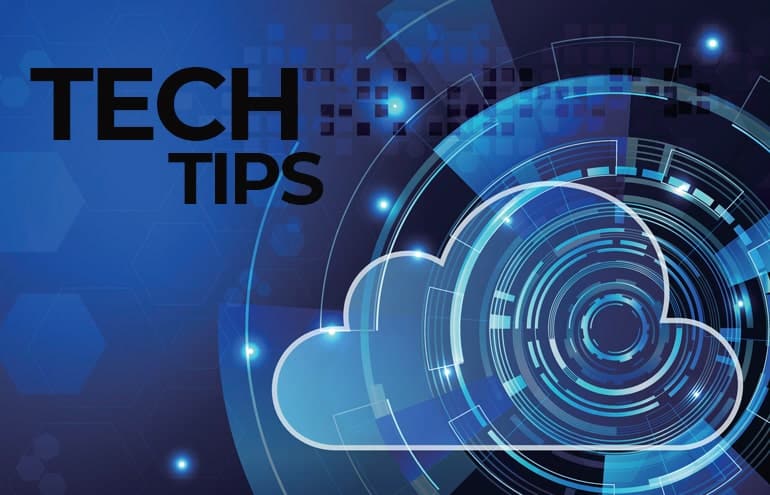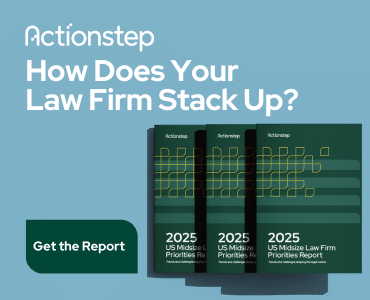What types of tools can enhance attorney productivity? Attorney at Work authors offer some ideas.
One thing we’ve definitely learned over the past year is that working remotely takes focus and resolve. (OK, and that to-go taco kits were the thing we’d been missing in our lives.) Now, with new year’s transition hiccups (mostly) behind us, we have no more excuses: It is time to get serious about productivity and efficiency!
So we asked a few practice management and technology experts: What’s your favorite productivity app, hack or even website to help lawyers and legal professionals master the working-remotely thing this year? Here are the ins-and-outs of some cool tools from Sheila Blackford, Brett Burney, Tom Lambotte, Sharon Nelson and John Simek, and Camille Stell.
Brett Burney: Tickling Your To-Dos and Collaborating on Calendars
I’ve always had a love-hate relationship with to-do and task management software because I definitely need them, but I end up spending more time making them all perfect instead of actually getting my real work done!
That’s why I was elated to find Microsoft To Do (formerly Wunderlist). It allows me to capture a simple yet elegant list of tasks so I can get everything out of my head but still have the confidence that I won’t forget anything. I usually assign a “due date” to each item, which means it will appear in my triage list for that day. But I only add a handful of tasks to the “My Day” list so I don’t get overwhelmed.
The best part is the satisfying “PLING!” sound when you complete a task, which is pure productivity dopamine. You can see the app in action (and hear it!) in my Apps in Law video, here, covering the mobile app.
Microsoft To Do is free and requires either a free Microsoft account or pairs nicely with Office/Microsoft 365.
Another tool that has become invaluable over the last year is Calendly, which has saved me from numerous “when can you meet?” back-and-forth emails. When someone needs to schedule a call, I send them a Calendly link and they pick a time that works for them. But the only time slots they see are what’s available on my business and personal calendars. I happily pay for the Pro tier, but even the free Calendly version integrates with Zoom, so the calendar appointment includes Zoom details too!
Brett Burney (@BBurney) is Principal of Burney Consultants LLC, an independent legal technology consulting practice. He is also a sought-after trainer and presenter for lawyers who seek to integrate Macs and iPads into their practice. Brett is a past ABA TECHSHOW Planning Board Chair and a popular speaker on legal technology.
Tom Lambotte: CloudApp Can Transform Your Communications
Consider this about “face-to-face” communications:
- 7% of a message is derived from the words.
- 38% is from the intonation.
- 55% is from facial expression or body language.
The vast majority of communication is not carried by our words alone.
Yet the majority of your communication in a given day happens with email or text —whether that’s via a text message, chat app like Slack or Microsoft Teams, Facebook, Twitter or so on. All of these are messages that only deliver words, losing both intonation and facial expression as well as body language. (Want a comedic interpretation of this? Check out Key & Peele’s take on it. I watch this with my team at least quarterly. Warning: NSFW.)
Enter CloudApp.
CloudApp saves at least two hours per week and 100x of value simply by clarifying my communications. This leads to less reworking, mistakes, misunderstandings, emails back and forth, and more. It allows me to capture what’s in my head so that I can provide quick, clear direction to my team and clients.
In the past, I wrote out long, detailed emails (that were often overwhelming to the reader), which took a looong time. You know what I’m talking about. With CloudApp, I click a button in my menu bar, choose what I need, and hit record. The primary options are to create a screen video capture, create a GIF (super handy!), capture the screen, or capture and annotate.
Screen video capture is my go-to — and if there’s no need to record the screen, you can record the camera only. Once finished, it auto-uploads to the cloud and copies the URL to your clipboard so you can paste it right where you need it. What would have taken me 10 minutes to write out, I can do in 45 seconds, from beginning to end. I hit record, “speak” my message, save to the cloud, and get the URL. It’s all effortless. Which means I am far more likely to use it — which I do. A lot.
CloudApp has a ton of super useful features, and tapping into their power can take the efficacy of your communication to new levels. The free app lets you do plenty to determine if you’ll get your money’s worth.
Install it and try it out. Prove your newfound attorney productivity by sending me a thank-you video to tom@globalmacit.com as proof you’ve joined the uber-productive. Don’t worry, it’s quick and effortless.
Tom Lambotte (@LegalMacIT) is CEO of GlobalMacIT, a company specializing in providing IT support to Mac-based law firms. Tom is the author of “Hassle Free Mac IT Support for Law Firms” and “Legal Boost: Big Profits Through an IT Transformation” and publishes the weekly “Stupid Simple Mac Tips” series.
Camille Stell: Guard Your Time Using the Pomodoro Technique
Working remotely requires self-discipline. The Pomodoro Technique, which you may have heard of, is a time management practice. The basic idea is to block off your time in 25-minute increments using a timer. I often struggle to keep my focus when I’m writing or working on big projects, and this is a favorite tool of mine. The technique is a simple concept and keeps me focused.
Beyond the core application of spending 25 uninterrupted minutes on a project, the concept is also about being more efficient with your time. Working in uninterrupted blocks can help you better estimate how long potential projects will take, which will aid you in setting fees. Also, research has shown that we learn better when we take periodic breaks from studying, as the new information has time to sink into our long-term memory. However, going for longer than 25 minutes can yield diminishing returns as your brain needs a break.
Key points to mastering the Pomodoro Technique:
- Determine how many 25-minute blocks it takes to do certain tasks.
- Learn to protect your blocks of time from internal and external interruptions.
- Learn to accurately estimate how many 25-minute blocks you need to complete particular activities.
- Use some of your 25-minute blocks of time not just for work but to organize and review your project.
- Set your task list according to your to-do items and available time — helping you organize your work.
- Finally, once you’ve mastered the technique, set your own personal goals such as improving your efficiency, producing higher-quality work, or allowing for more free time or strategic time in your day.
Another tip: A common approach with the Pomodoro Technique is to work for four 25-minute stretches with five-minute breaks in between. Upon completion of the last 25-minute stretch, take a longer break. For example, I leave my home office and head downstairs for more water, a snack or a walk to the mailbox.
Apps you can use for the Pomodoro Technique include Pomodoro Timer, Tomato Timer, Emphasis-Focus Timer and Focus To-Do. Some emphasize to-do lists and other add-ons. Or, just set the timer on your phone and start working.
Camille Stell (camille@lawyersmutualconsulting.com) is President of Lawyers Mutual Consulting & Services and a specialist in working with lawyers on building modern law firms, as well as retirement and succession planning.
Sheila Blackford: Start by Identifying Your Productivity Problem
To Gertrude Stein’s remark about her hometown of Oakland, California, “There is no there there,” I remark about attorney productivity apps, hacks and websites that “There is no hand-it-to-me-fix fix.”
When you have sidled off the productivity road at the office, you can always look busy, frown at your computer screen, massage your chin thoughtfully, make editing marks on your shopping list … you know, expend effort on the artifice of looking productive. Unfortunately, 2021 has shown up and we’re still house-bound working remotely, and those pho-productive tricks just don’t fool the dog.
Here are some ideas I have found helpful that might enhance your productivity, too.
Identify the problem. I can’t tell you how many self-help books and tapes and motivational speakers I have dropped some serious change to embrace. You can’t go finding a solution to a problem you don’t know you have. What is your main productivity problem? Mine is that I have a lively mind that bounces around, so I’m easily distracted by all the fascinating things going on around me … what is that outside my window?!
I have made peace with this hyperactive attention. Call it attention overload disorder, or “blue jay syndrome,” named for the blue jay’s fascination with any shiny thing on the ground. So the problem is the need to shut down extraneous stimulation, your favorite shiny things.
Identify some of your own solutions. Many lawyers and law students have this problem, hence the great idea of the study carrel in the law library. The concept is brilliant: a chair, a completely clear work area, enclosed on three sides with raised partitions to keep your eyes on your work. Or you may be familiar with the work cubicle, which is not at all cozy. When I need to hunker down to focus, I first establish my Sanity Square, an invisible desk blotter of empty space on the desktop before me. If there is clutter on the desk, you can be sure that I will become distracted perusing it.
Perhaps external noise is distracting you? Use an air purifier like this, good for your allergies while producing three volumes of white noise: Renpho ($79.99 on Amazon). Although I don’t own a pair, Bose Noise-cancelling Headphones might also be helpful ($299 on Amazon for Bose QuietComfort 35 II Noise-Cancelling Bluetooth Headphones with Alexa voice control). Or, just pick up some disposable foam ear-protector plugs ($14.78 at Home Depot).
Loathe to focus? I like the Pomodoro Technique that Camille discusses. You can use a fancy Pomodoro tomato timer or your cellphone timer. I find I like the sound of ticking as it gives me a bomb-like sense of urgency. (Adrenaline junkies are procrastinators, and vice versa.) Another idea for when you’re working later: Set deadlines 15-minutes before an episode of “The Expanse.” Or do the reverse and forgo Netflix if you don’t get your work done.
Commit to doing one thing differently. I’m not going to tell you what that one thing is for you. For me, I commit to blocking out a set time to work at something I’d like to postpone. Is that popcorn I smell? It’s time for Netflix.
Sheila M. Blackford (@SheilaBlackford) has been a Practice Management Attorney for the Oregon State Bar Professional Liability Fund since 2005. She is the author of the ABA book “Trust Accounting in One Hour For Lawyers,” co-author of “Paperless in One Hour for Lawyers,” and a contributing author to “Flying Solo: A Survival Guide” and the Oregon State Bar “Fee Agreement Compendium.”
Sharon Nelson and John Simek: Get the Networking Speed You Need to Boost Attorney Productivity
The work-from-home environment has placed additional mental and technological stress on lawyers as they try to effectively practice law remotely. Videoconferencing has been a huge help in staying connected with clients and colleagues. Accessing cloud services allows attorneys to avoid trips to the office and access client data from the comfort of their own homes.
Having adequate network speed is critical for the success of remote computing. One major challenge during the pandemic is how to maintain sufficient network bandwidth. Typically, we connect to the Wi-Fi network and hope our video doesn’t freeze while participating in a virtual hearing. In addition, we’re competing for bandwidth with our spouse, children and other family members as they also work remotely or remotely attend school.
What are the options for improving network speed?
The first suggestion is to get off Wi-Fi and directly connect to your router via Ethernet. Not everyone has hard-wired Ethernet in their residence. There are options there too. If you are not too far from your router, you can purchase a long Ethernet patch cord to connect to your computer. Just make sure the cable isn’t a tripping hazard.
Another alternative is to purchase Ethernet over Powerline adapters such as the TP-Link AV1000. You can get a set of adapters from Amazon for around $50. Basically, here’s the setup:
- You plug one adapter in an electrical outlet near the router and connect a patch cord from the adapter to a router port.
- Plug the second adapter into an electric outlet near your computer.
- And connect a patch cord from the adapter to the Ethernet port on your computer.
The adapters communicate with each other over the electrical wiring in your house.
The Ethernet over Powerline adapters work very well for most installations. However, it is not guaranteed to improve your network speed. You can always return the adapters if they don’t work with your wiring. For $50, you really can’t go wrong.
A more expensive alternative to increase your network speed is to upgrade your Wi-Fi network. Replace your Wi-Fi router with a Wi-Fi 6 device. Wi-Fi 6 has improved security, greater capacity (can handle more connected devices) and speed.
If you’re looking to improve your Wi-Fi network’s coverage area, investigate upgrading to a mesh network. We did — and it made a world of difference!
Sharon D. Nelson (@SharonNelsonEsq) and John W. Simek (@SenseiEnt) are President and Vice President of Sensei Enterprises, Inc., a digital forensics, legal technology and cybersecurity firm based in Fairfax, Va. They have written 16 books published by the ABA, including “The Solo and Small Firm Legal Technology Guides” and “Encryption Made Simple for Lawyers.”
Illustration ©iStockPhoto.com
You Might Also Like …
“Working From Home: 5 Productivity Hacks to Help You Get More Done”
“Productivity Tools and Tips to Jump-start Your New Year”
“Journaling: Your Work-Life Balance Power Tool”
“Running the Day More Productively”
Subscribe to Attorney at Work
Get really good ideas every day for your law practice: Subscribe to the Daily Dispatch (it’s free). Follow us on Twitter @attnyatwork.
















